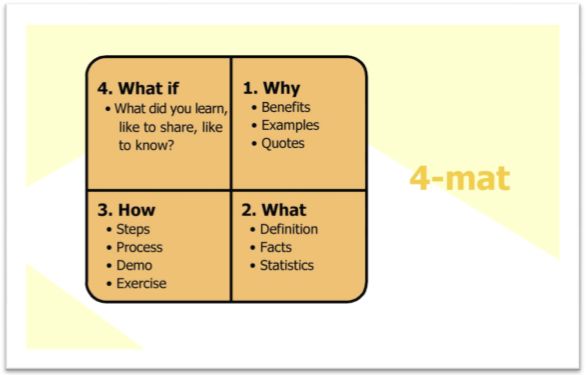Here is the only way to structure a winning presentation.
When followed, this structure, known as 4-mat, guarantees that your presentation will connect with each of the 4 main learning styles. This means you’ve got everyone in the audience covered from the strategic thinker, to the hands-on type, to the creative daydreamer, to the data crunchers.
People Have Different Learning Styles
People have different learning styles, which can be synthesized into four main types of people: “What” people, “Why” people, “How” people and “What if” people. By ensuring that your presentation answers the core question of each learning style, your content will get through to everyone in your audience. The order in which you answer each learning style is critical, so every presentation should first cover Why, then What, next How and last What if.
Here is How You Structure a Great Presentation
1. Address the needs of the “Why” People first
“Why” people need to know why before they begin anything. So, give them a reason to learn up front. Tell them the benefits of what you are about to teach them. Tell them stories and give examples of the benefits. Make sure you address the “Why” people in the first 10 minutes or they will tune out for the rest of your talk!
2. Next address the needs of the “What” People
“What” people need the facts in order to get a conceptual understanding. They are interested in what you know and what you want them to know. So, give them lots of information and facts to deepen their understanding. They love quotes, examples and definitions.
3. Tell the “How” People how it works
“How” people need to know how things work. They are good at finding practical uses for ideas and theories. So, give them the steps they need to do it them self. Give them an opportunity to try things out. They need to participate in an exercise of what you are teaching before they will really “get it”.
4. Let the “What if” People ask their obscure questions (I love the what-ifs!)
“What if “ people are interested to know if what they know can create new possibilities. They need to know, “what would happen if…” So, let them ask questions but get them to save the questions till the end of your talk otherwise they can involuntarily take things off on obscure and unhelpful tangents.
Keep it Simple
You are probably telling yourself that this is way too simple to really work but I guarantee that it works a treat. I use it in all of my presentations. 4-mat always gets rave reviews from people who use it because they never have to start with a blank page again.
Just imagine, with 4-mat you never need to design a presentation from scratch!
From now on, every time you sit down to develop a presentation all you need to do is answer the following questions about your topic and then beef up each section to fill up the allotted time frame of your talk:
- Why is this topic important?
- What is it?
- How do you do it?
- What will happen as a result?
Happy Presenting!
For additional coaching tools, check out our shop for professionally formatted coaching programs and worksheets that you can modify and rebrand for your coaching practice.


